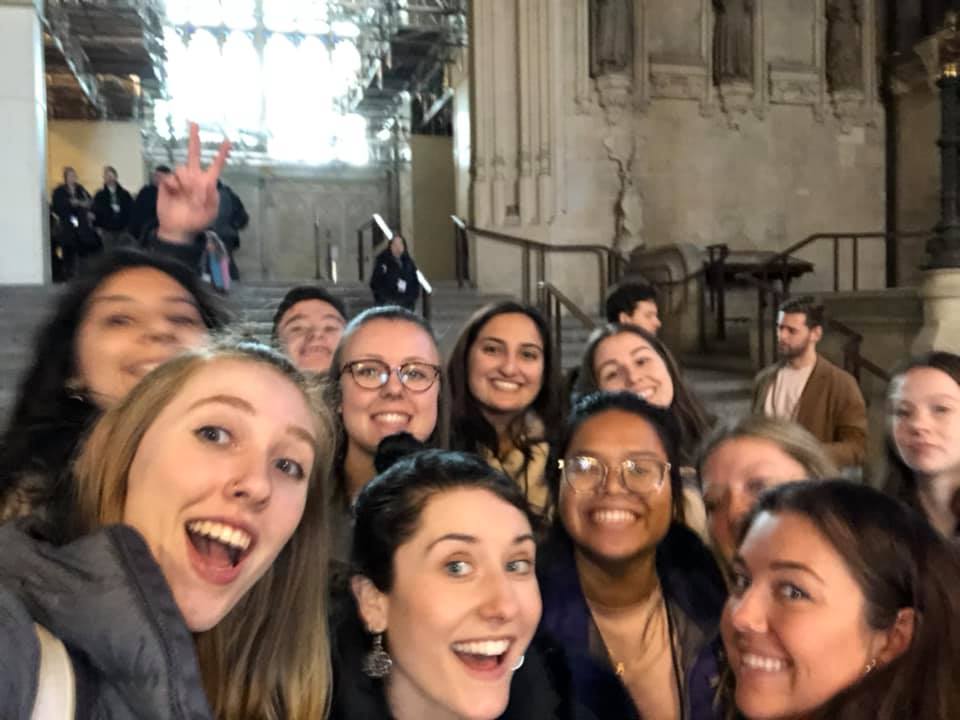We enter Parliament through its oldest surviving section, Westminster Hall. The sudden quiet is bracing, as the building’s six-foot-thick stone walls insulate us from the busy background hum of London. This imposing space invites solemn reflection on the past and a bit of unabashed rubbernecking too.
It was the largest hall in Europe when completed in 1097. The king who commissioned it, William Rufus, lesser-known son of the Conqueror, was not as impressed with Westminster Hall as we are. He expected it to be twice as big. At least, that’s what our tour guide tells us. Held together without a single nail, its hammer-beam wooden roof spans sixty-eight feet and survived a fire that devastated the rest of Parliament in 1834. Oh, and not one but two—count ‘em, two—World Wars. Charles I, the only English king to ever be executed, was tried and convicted here; more recently and much less morbidly, Westminster Hall has hosted the esteemed likes of Charles de Gaulle, Nelson Mandela, and our very own Barack Obama.
There’s no photography past this point, so all phones emerge to snap pics. It’s strange to think that these are the only photos we come away from our visit with. When my mother asks, How was Parliament?, she expects to hear about the name-brand chambers: the House of Commons, House of Lords, and on account of her addiction to The Crown, probably the Queen’s Robing Room. None of those comes anywhere close to Westminster Hall in terms of age or historical significance.

Our Liberal Arts in London students enjoying Westminster Hall, with me in the background looking thoughtful! Photo by Maddie H.
As an American in Britain, I’m regularly confronted with things that are almost unbelievably old, and often, otherwise unremarkable. It’s part of the appeal of studying here. (Let’s be honest, we don’t come for the weather.) We get a kick out of saying to ourselves, Jeez, that’s older than America! And they put a McDonald’s in it?! GEO in London’s homebase at 6 Great James Street? One birthday shy of three hundred. Euston railway station? Older than the oldest building in the whole state of Oregon. The road where your tube stop is? Yeah, the Romans built that. That’s why it comes as a surprise that most of what we spend the morning gawking at in Parliament isn’t very old at all.
Sure, as an institution Parliament has one foot in the murky, misty deep past of the Magna Carta and King Arthur. (They’re connected, right?) Not all of this romanticised British past is quite so distant. When it comes to the immense murals of the battles of Trafalgar and Waterloo, students in Keith Surridge’s class on “Britain in the Age of Revolution and Reform” perk up their ears immediately at the mention of Admiral Lord Nelson. Yet the events depicted in these images were in the living memory of the man who painted them. That devastating fire I mentioned earlier did away with almost everything originally located on the site, and what we see today dates from around the time our own Civil War was brewing over in America.
At the opposite end of Westminster Hall from the entrance, where we’re deposited at the conclusion of our tour, our guides stops us and we stare up at a newly installed sculpture. Titled “New Dawn,” it commemorates the long campaign that eventually led to British women winning the right to vote in 1918. (Not all women, mind you: at first, only women over thirty.) A circle of variously sized coloured light bulbs glows and dims in response to the tides of the Thames. This rose window-like design is set against a raised portcullis, both recalling brooches designed and worn by imprisoned suffragettes and symbolising the opening up of the democratic process to the long excluded other half. To me, it feels fitting that the oldest and the newest bits of Parliament are separated by about a dozen stone steps, fifteen feet or so.
I spent six transformative months in Britain in 2017 as a student and moved to London on a permanent basis (as permanent as it gets at my age) after graduating in 2018. Since then, many of the questions I keep asking myself come back to the relationship between the past and the present. How should we think about what’s come before us in light of the way our world is now? How did we get here in the first place? How did I get here? Individuals are rarely the stable, unitary subjects we take ourselves to be. Our social institutions, on the other hand, depend as much on their ability to change with the times as on their continuity (or at least the appearance of it) across generations. Nothing better embodies this productive tension between apparent contradictions than the physical space of Parliament itself.
Iain Espey, Programmes Assistant


Leave a Comment
You must be logged in to post a comment.